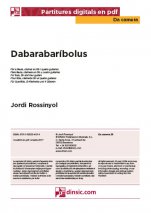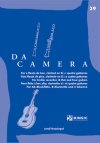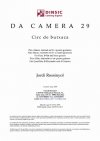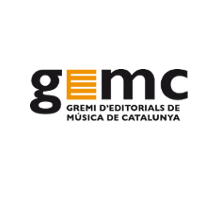Dabarabaríbolus

Inside Pages
Author/Composer
Field
Music Schools and Conservatoires Elementary Level
Scores Elementary
Collection
Da Camera (separate PDF pieces) Nr. 2901
Language
Spanish, Catalan, Music, English, French, German
Format
Technical Specifications
Measurements
21 x 29,7 cm, vertical
Number of Pages
12
ISMN
979-0-69232-403-4
Editor
DINSIC Publicacions Musicals
Related Publications
Da Camera 29: Pocket Circus
Array
(
[Relacionat] => Array
(
[id] => 1531
[publicacion_id] => 12656
[publicacion_id1] => 2275
[type] => relacionada
)
[pub] => Array
(
[Publicacion] => Array
(
[id] => 2275
[titol] => Da Camera 29: Pocket Circus
[url] => score-dc29-da_camera_29_pocket_circus
[codi] => DC29
[intro] =>
[continguts_generals] => These pieces can be played separately, though in view of their duration it is preferable to play them straight through. They were intended as original chamber music for elementary-level students. The instrumentation can be adapted to meet varying needs and teachers' tastes.
The titles of pieces 2, 3 and 4 were prompted by reading the unforgettable works of the poet Joan Brossa, who was always fascinated by the world of magic and conjuring tricks. Though the relationship between the music and the title is wholly subjective, there is some resemblance between the musical result and the music typically used to accompany circus acts. A small-scale circus that everyone can feel at home in.
[estructuracio] => 1.- Dabarabaríbolus
2.-The cage
3.-The file inside the bread
4.-Magnet
[material_descarga] => 0
[titol_descarga] =>
[info_descarga] =>
[num_pags] => 20
[ismn] => M-69210-114-7
[diposit_legal] =>
[codi_barres] =>
[isbn] =>
[preu] => 18.03
[exhaurit] => 0
[oferta] => 0
[en_preparacio] => 0
[recomanat] => 0
[novetat] => 0
[format] => Partitura
[ctecnica] =>
[ilustracion] =>
[num_pagines_interiors] => 0
[n_pag_annex] =>
[numero_particelas] => 6
[numero_pagines_particelas] => 24
[durada] =>
[visible_instrumentacio] => 1
[visible_formacions] => 1
[pdf_car_estructuracio] => 0
[pes] => 0,15
[published] => 1
[created] => 2006-07-31 16:55:53
[modified] => 2025-06-26 12:54:15
[ordenacion] => 2006-07-31 16:55:53
[puntuacio] => 0.00
[visto] => 4745
[rating] => 0.0
[votes] => 0
[parent] =>
[has_child] => 0
[locale] => en_gb
)
[Audit] => Array
(
)
[Category] => Array
(
[0] => Array
(
[id] => 88
[url] => basico
[name] => Básico
[parent_id] => 78
[descripcio] =>
La clasificación del nivel de una partitura normalmente viene determinado por el grado de dificultad técnica del instrumento o voz. En los casos de obras para formaciones instrumentales diversas, orquestales, vocales, etc. el nivel se determina atendiendo a la complejidad general de la obra, no a la de sus instrumentos en particular. Es muy importante conocer este criterio porque las obras de conjunto aparecen también en los listados específicos de cada uno de sus instrumentos o voces que participan en él, pero el nivel que se indica es el de la formación instrumental-vocal.
[order] => 2
[lft] => 2
[rght] => 3
[published] => 1
[PublicacionsCategory] => Array
(
[id] => 285
[publicacion_id] => 2275
[category_id] => 88
)
)
)
[Idioma] => Array
(
[0] => Array
(
[id] => 116
[nom] => Catalan
[published] => 1
[url] => catalan
[PublicacionsIdioma] => Array
(
[id] => 482
[publicacion_id] => 2275
[idioma_id] => 116
)
)
[1] => Array
(
[id] => 103
[nom] => Castellà
[published] => 1
[url] => castella
[PublicacionsIdioma] => Array
(
[id] => 483
[publicacion_id] => 2275
[idioma_id] => 103
)
)
[2] => Array
(
[id] => 1724
[nom] => English
[published] => 1
[url] => english
[PublicacionsIdioma] => Array
(
[id] => 484
[publicacion_id] => 2275
[idioma_id] => 1724
)
)
[3] => Array
(
[id] => 1880
[nom] => German
[published] => 1
[url] => german
[PublicacionsIdioma] => Array
(
[id] => 486
[publicacion_id] => 2275
[idioma_id] => 1880
)
)
[4] => Array
(
[id] => 1879
[nom] => Francés
[published] => 1
[url] => frances
[PublicacionsIdioma] => Array
(
[id] => 1873
[publicacion_id] => 2275
[idioma_id] => 1879
)
)
[5] => Array
(
[id] => 142
[nom] => Music
[published] => 1
[url] => international
[PublicacionsIdioma] => Array
(
[id] => 9114
[publicacion_id] => 2275
[idioma_id] => 142
)
)
)
[Rsspost] => Array
(
)
[Archivesrelation] => Array
(
[0] => Array
(
[Archivesrelation] => Array
(
[id] => 1944
[model] => Publicacion
[foreign_id] => 2275
[order] => 0
[file_id] => 2548
[archivestypes_id] => 2
)
)
[1] => Array
(
[Archivesrelation] => Array
(
[id] => 1945
[model] => Publicacion
[foreign_id] => 2275
[order] => 0
[file_id] => 2549
[archivestypes_id] => 3
)
)
)
[PublicacionsIdioma] => Array
(
[Idioma] => Array
(
[id] => 116
[nom] => Catalan
[published] => 1
[url] => catalan
[locale] => en_gb
)
)
)
[path] => scores-elementary
)
18.75 €
Da Camera 29: Pocket Circus
15.64 €











